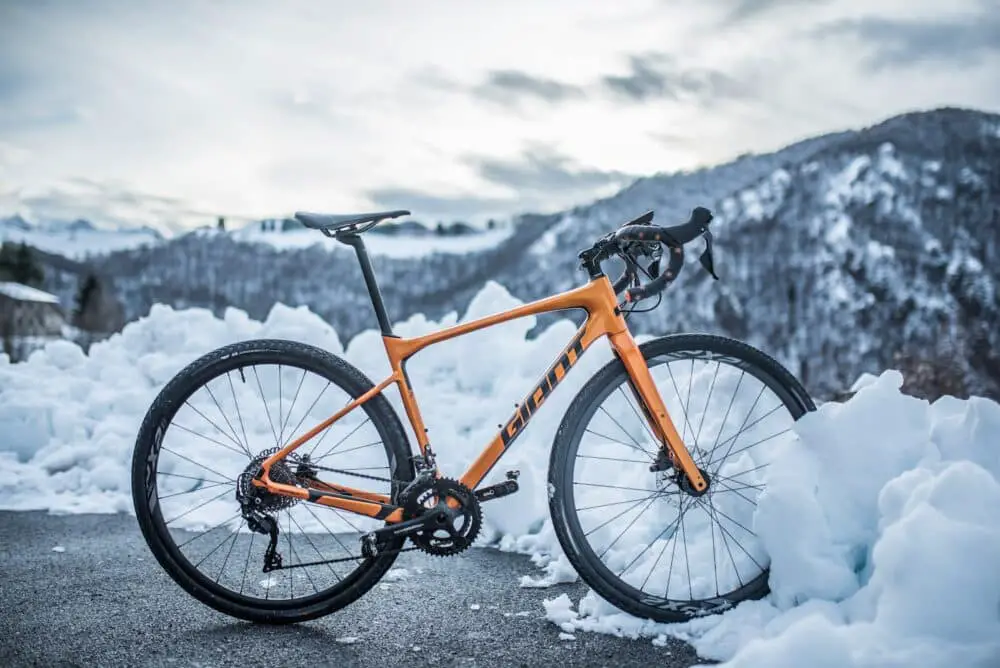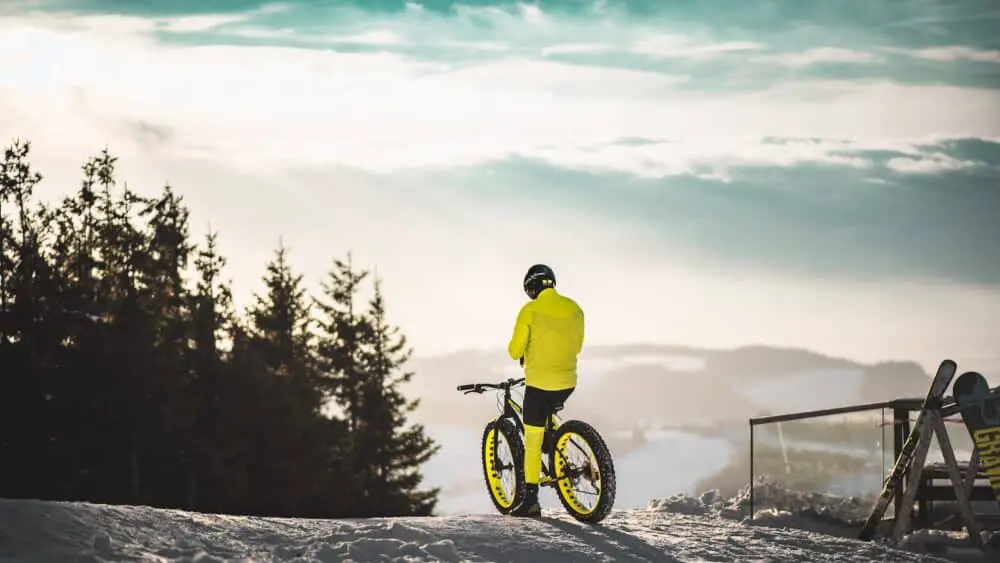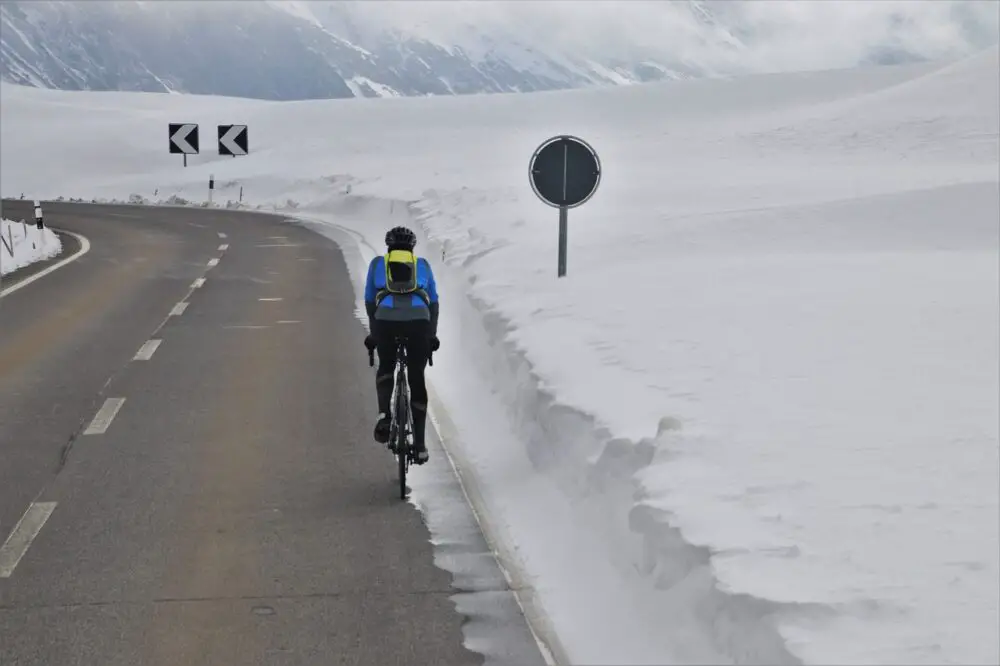For many of us who are experiencing cold weather, the prospect of pedaling outside in cold temperatures gives us shivers. But you shouldn’t use that as an excuse to hibernate your house. Warm clothes & riding kit have come a long way, and you can still hit the trails and asphalt with the help of planning ahead and layering.
The best way to stay warm when cycling is to prepare before you go with the correct riding clothes, kits & gear.
Although each person’s tolerance for the cold varies, maybe this guide can save you from making the same early cold mistakes many people make while winter riding.

General Guidelines
When getting ready for winter cycling, a good rule of thumb is to start out wearing what is a little cooler than you’re comfortable with since, after about 10 minutes of pedaling, you’ll warm up rather well.
It could take some trial and error before you find the proper balance because overheating can be painful if you overdress.
And always, check the tire pressure so that you can reduce or add air pressure for a better and safe riding experience as tires lose pressure over time during colder weather.
Layer Up
Winter cycling is challenging since your body becomes warmer the harder you push. The best way to remain warm is to wear in layers that you can take off as you warm up. This is by far the best way to keep your core warm.
To assist perspiration evaporate, start by putting on a light base layer. Add leg warmers, arm warmers, bib shorts, and a jersey layer to your outfit if it’s really chilly. The finishing touch should be a warm jacket or cold-weather cycling gear.
You may need additional vests and thermal bib tights to keep your chest region warm if it is severely chilly outside. Attempt to avoid perspiring by removing layers of bike-specific clothing before it’s too late; perspiration will freeze and leave you and your clothing damp and chilly.
Face, Neck, and Head
Road helmets without vents can keep your head warmer, particularly when worn with a windproof skullcap or a classic Belgian winter hat. Your eyes will be shielded from spray and chilly gusts by wearing glasses with transparent or light-enhancing lenses.
If it gets particularly chilly, you can draw a neck tube in the snood style over your nose and mouth to keep your neck warm.
Wind Chill and Ride Speed

Due to the different speeds and wind chill you’ll be feeling on the bike, fat biking at 6 mph is much warmer than riding a road bike at 20 mph on bike paths. A fast road ride can seem like it’s being driven into cold 25 mph winds, even with a 5 mph wind speed.
However, at slower speeds, such as those encountered on a fat bike ride, your effort rate will keep you warm without the help of the added wind speed.
As you are winter cycling, consider your surroundings. While mountain bike or fat bike rides may be conducted on a forested track with many trees to shelter you from the wind, road rides are frequently conducted in the open.
A popularly preferred paved surface for a winter ride is a nearby bike path that is entirely shaded by trees on both sides (and hence considerably warmer than the open road!).
Ensure Your Extremities Are Warm
When your core temperature starts to drop, the first body parts to get chilly are your hands and feet. Also relevant is the wind chill factor. While winter cycling, your hands, and feet are facing the wind.
Heat may be easily removed by cold air flowing over them. Frostbite is a concern in severely chilly conditions. Additionally, wool socks, or really any thick socks provide amazing value when trying to stay warm in winter conditions.
Cycling in cold weather becomes unpleasant and even painful rapidly when your fingers and toes are frozen. Additionally, winter cycling gets more challenging. Your fingers lose dexterity when it’s chilly outside.
As a result, it is challenging to use the bike parts like the shifters and press the brake levers. When your hands are frozen, you can’t handle the bike as precisely.
You can have problems keeping your cadence if your feet become too chilly. You’ll feel awkward. It’s crucial to put on sturdy winter cycling gloves and accommodate thicker socks.
Remember to Stay Hydrated
Winter cycling has strange effects on how hydrated your body is. On the one hand, breathing becomes more active, which raises your thirst since cooler air is drier than warm air. On the other side, lower temperatures result in lower rates of sweat, which reduces your requirement for hydration.
In conclusion, it’s difficult to determine whether you should adjust your hydration requirements when riding in the cold. The response varies from person to person and is influenced by how hard you winter bike ride. Since you aren’t really perspiring during a cold weather endurance ride, for instance, you might not need to drink as much.
However, you’ll perspire heavily and need to drink more fluids than normal during a road race in 30°F temps due to the dry air. Avoid drinking cold water as it will cause your body temperature to drop. It’s best to drink lukewarm water instead.
Here are some fundamental guidelines for staying hydrated in the cold:
- The average person needs 12 to 16 ounces of fluid every hour, or about one cycling water bottle, so be aware of this.
- During sweaty, intense rides, consume more fluids.
- During easy, non-sweating rides, reduce or keep your fluid intake.
It would be a pity to spend the entire winter indoors because it is one of the loveliest seasons of the year. Remember to dress correctly, be adaptable with where and when you ride, and change your hydration and nutrition plans in order to bike or race outside in wet weather.
Take Quick Breaks
Your body temperature starts to drop when you stop cycling. Sweating starts to evaporate, cooling you off. Clothing that is wet quickly transmits heat away from your body. You might get a chill.
It might be tough to warm back up after becoming chilly. If you pause too long, your muscles and joints could also begin to feel stiff. In the cold, keep your pauses to no more than a few minutes to stay warm.
If you need to stop for a longer period of time, pick a wise location. Locate a location near the base of an incline. That way, when you start cycling again, you’ll have to exert yourself. You’ll get heated up fast.
Additionally, attempt to stop in the sun as opposed to the shadow. Even on a chilly winter day, the sun may make you feel warmer. If you stop to visit a shop, restaurant, café, etc., stay inside the cosy confines for some time.
Soak in the heat. Find bike racks to wait for your wet clothing to start to dry out. Never stop for a rest atop a long, shaded slope. You’ll get frozen as you descend.
Bonus Tip: If the ground is ice, use caution when mounting and dismounting your bike. You can also use studded bike tires in order to be extra safe on the snow-filled bike lane roads. Make sure to check the tire pressure of the studded tires before heading out. Even if your tires have lots of traction, your shoes might still slip. Watch cautiously for icy areas.
Air pressure decreases more quickly at cold temperatures than usual. That’s why bike breaks down quite commonly during the winter season. During the winter, you might want to convert to slightly wider bike tires.
They make cycling more convenient by enhancing grip on slick areas. Make sure that the rear lights, disc brakes, rim brakes, and other bike parts are in top condition. Also, keep spare batteries with you if you plan to ride regularly in the wet weather.
Before Leaving
Check to see if you have a filling breakfast or, if you’re cycling in cold weather and later in the day, a sufficient snack or supper to sustain you for the ride.
You will feel the cold more keenly and lack the stamina to pick up the speed necessary to warm up if your blood sugar levels fall. In order to practice safe winter riding, it’s crucial to fuel properly before going for a cycling ride in winter.
To get them warmed up, place your socks, shoes, and bike gloves close to a radiator. Check tire pressure before every ride. Only a little while longer, the warming boost might really help you get out the door.
If your drink is hot, think about utilizing insulated flasks. It works great to drink green tea with honey.
Avoid overdressing; otherwise, you’ll perspire, become cold, and possibly need to stop to take off layers. When you first start out, you could feel a little chilly, but after you get rolling, everything will feel fine.
Conclusion
By following the tips above, you can stay warm while cycling in cold weather. Cycling is a great way to get exercise during the winter, and it’s possible to stay warm if you dress properly and be aware of your surroundings. Remember to stay hydrated, even if you don’t feel like you’re sweating, and enjoy the season!
References
Staying warm on the bike. (n.d.). British Cycling. Retrieved October 10, 2022, from https://www.britishcycling.org.uk/knowledge/bike-kit/clothing/article/izn20150127-Cycling-Winter-Clothing-Guide-0
Reeve, B. (2019, January 10). Cycling in Cold Weather | How to Layer Clothing and Stay Warm. Yellow Jersey. https://www.yellowjersey.co.uk/the-draft/cycling-in-cold-weather/
Kaib, F. E. and T. (2006, January 8). Cold-Weather Riding: Tips to Stay Warm on the Bike. ACTIVE.com. https://www.active.com/cycling/articles/cold-weather-riding-tips-to-stay-warm-on-the-bike-875480
Bettin, A. (2021, November 30). Cycling in Cold Weather: How to Dress, Fuel, and Hydrate. TrainingPeaks. https://www.trainingpeaks.com/blog/cold-weather-cycling/#:~:text=Start%20with%20a%20light%20base
Rogers, M. (2021, December 21). The Best Winter Cycling Gear For 2022. https://www.informedcyclist.com/winter-cycling-gear/




